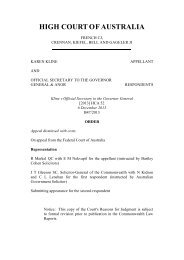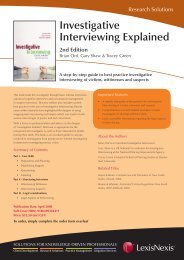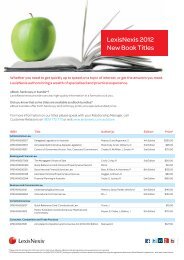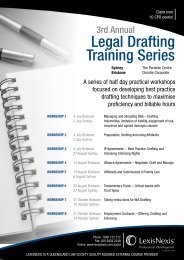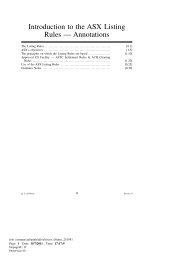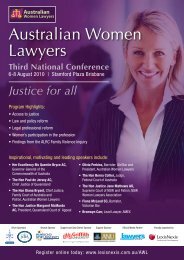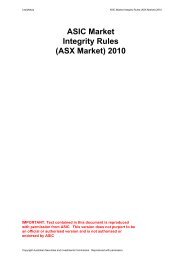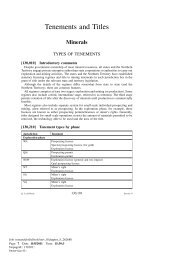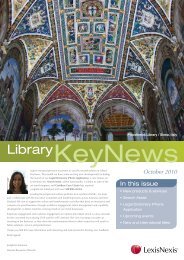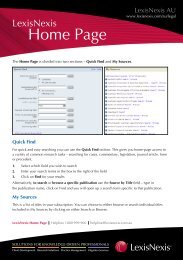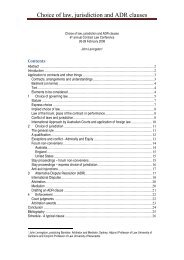Chapter 2 - LexisNexis
Chapter 2 - LexisNexis
Chapter 2 - LexisNexis
You also want an ePaper? Increase the reach of your titles
YUMPU automatically turns print PDFs into web optimized ePapers that Google loves.
the content of sub-s 43A(3) and the meaning of the phrase “so unreasonable<br />
that no authority having the functions of the authority in question could<br />
properly consider the act or omission to be a reasonable exercise of its<br />
function.” Such wording can be seen to have its source in what is often<br />
referred to as “Wednesbury unreasonableness” from Associated Provincial<br />
Picture Houses Limited v Wednesbury Corporation [1948] 1 KB 223 at 229-<br />
230. Regard could equally be had to the formulation of cognate concepts in<br />
Avon Downs Pty Limited v Federal Commission of Taxation [1949] HCA 26;<br />
78 CLR 353 at 360; R v Connell; ex parte Hetton Bellbird Collieries Limited<br />
[1944] HCA 42; 69 CLR 407 at 430; and Buck v Bavone [1976] HCA 24; 135<br />
CLR 110 at 118-119. Cognate ideas are also found in the law attending the<br />
responsibility of company directors. The Court there focuses on whether<br />
decisions made by boards are made honestly in the interest of the company or<br />
are of a kind which no reasonable person could have reached: see<br />
Shuttleworth v Cox Brothers and Co (Maidenhead) Limited [1927] 2 KB 9 at<br />
23-24; Peters’ American Delicacy Co Ltd v Heath [1939] HCA 2; 61 CLR 457<br />
at 481; and Wayde v New South Wales Rugby League Limited [1985] HCA<br />
68; 180 CLR 459 at 469-470. While these are different areas of human<br />
endeavour, formulations of the kind used in these cases, whether it be in<br />
public law, the law of business or the law of torts are attempts to formulate<br />
more attenuated tests for legitimate activity than by reference to a fixed<br />
standard of reasonable care. Whether it is appropriate to describe s 43A as<br />
encapsulating the blunt expression of “gross negligence” is a matter for<br />
debate. However, it is plain that the drafter of s 43A was attempting to<br />
ameliorate the rigours of the law of negligence. …...’<br />
9.18 Apologies<br />
• Dovuro Pty Ltd v Wilkins [2003] HCA 51; 215 CLR 317. Consideration of<br />
the extent to which a court may interpret an apology or admission as<br />
determining liability or assisting in a determination of liability.<br />
<strong>Chapter</strong> 10<br />
10.15 Cases regarding the exclusion of the plaintiff’s evidence<br />
• Neal v Ambulance Service of New South Wales [2008] NSWCA 346: See<br />
discussion at [40] – [42] regarding the practical effect of the exclusion:<br />
“Whatever the real purpose of the provision, the issue for determination is<br />
how a court is now to identify what course the plaintiff would have taken,<br />
absent negligence. That assessment might include evidence of the following:<br />
(a) conduct of the plaintiff at or about the relevant time; (b) evidence of the<br />
plaintiff as to how he or she might have felt about particular matters; (c)<br />
evidence of others in a position to assess the conduct of the plaintiff and his or<br />
her apparent feelings or motivations, and (d) other matters which might have<br />
influenced the plaintiff….Properly understood, the prohibition on evidence<br />
from the plaintiff about what he or she would have done is of quite limited



